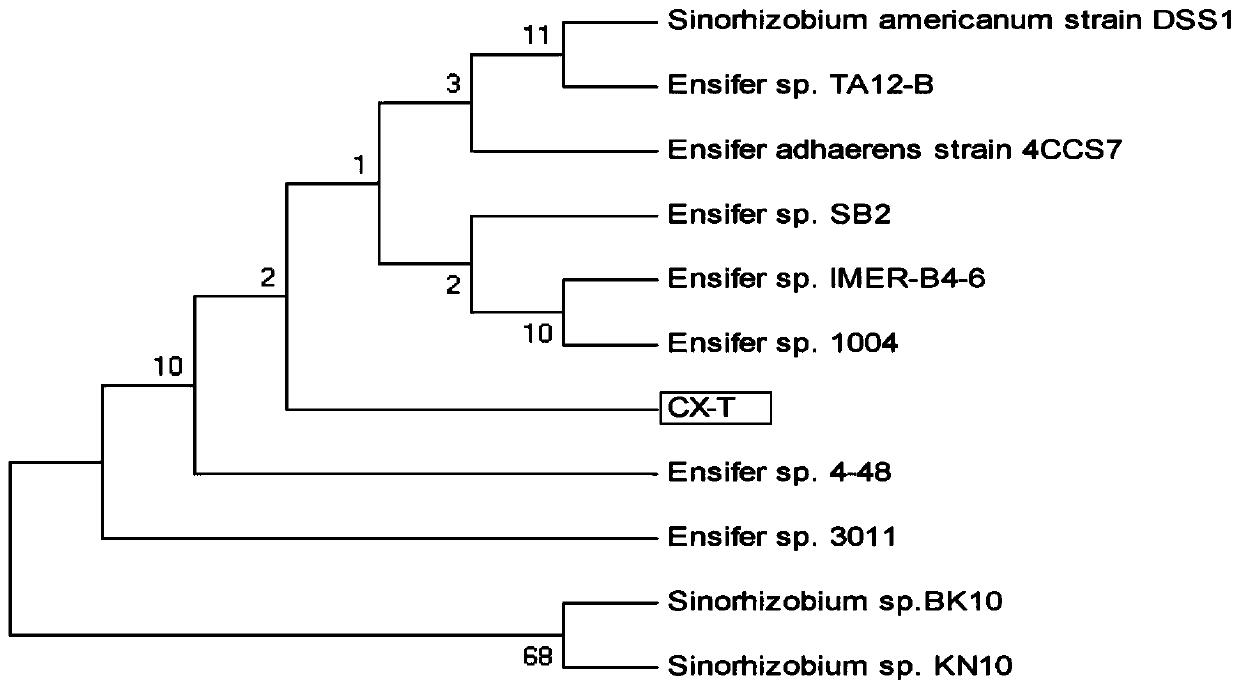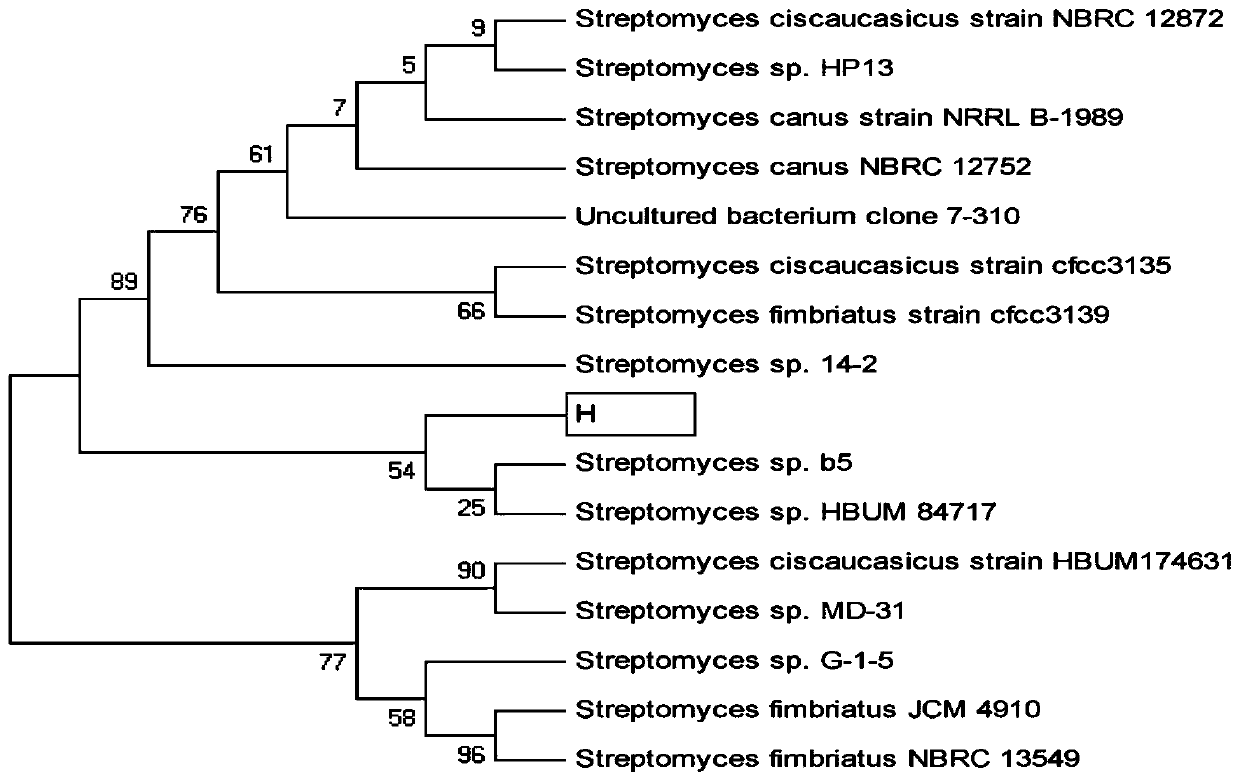A kind of atrazine-degrading bacteria and its application
A technology of atrazine and degrading bacteria, applied in the direction of bacteria, biological water/sewage treatment, microorganisms, etc., can solve the problems of food and drinking water safety, high cost and difficult implementation, and difficult treatment, etc., to achieve good degradation properties, good engineering application potential and application prospects, and the effect of high degradation efficiency
- Summary
- Abstract
- Description
- Claims
- Application Information
AI Technical Summary
Problems solved by technology
Method used
Image
Examples
Embodiment 1
[0040] Screening of CX-T strains: The strains capable of degrading atrazine were isolated from soil samples by means of enrichment culture and streak separation, and the degradation efficiency was preliminarily evaluated to screen out efficient degrading strains.
[0041]1. Reagents required: Atrazine standard (ATR): Dr.Ehrenstorfer, 99.8%; Atrazine original drug: TCI, 99.6%; Chromatographic pure reagents such as acetonitrile were purchased from Shanghai Anpu Company; yeast extract, peptone, Agar powder, etc. are domestic analytical reagents.
[0042] 2. Medium
[0043] Basal medium (MSM, g / L): K 2 HPO 4 ·3H 2 O 1.60g, KH 2 PO 4 0.40g, 3.00g sucrose, MgSO 4 ·7H 2 O 0.20g, NaCl 0.10g, CaCl 2 0.02g, atrazine (1g / L methanol solution) 10mL, trace elements 5mL, dH 2 O1000mL
[0044] LB medium: yeast extract 5g, peptone 10g, NaCl 5g, dH 2 O 1000mL
[0045] All the above mediums were steam sterilized at 121° C. and 0.1 MPa for 20 minutes, and 20 g of agar powder was add...
Embodiment 2
[0066] Identification of degrading strains
[0067] Main reagents: SPIN Kit for Soil(MP), Taq DNA polymerase, dNTPs, agarose, 18-T Vector Ligation Kit, Plasmid Extraction Kit, H 2 o 2 , crystal violet, safranin, oxidase, etc.
[0068] This example only conducts a simple analysis of the characteristics of the strains such as Gram staining, catalase, and oxidase. For specific principles, please refer to the "Common Bacterial System Identification Manual".
[0069] Genome extraction: Purified strains were inoculated with LB medium for overnight culture, according to SPIN Kitfor Soil Operation Manual Add the strain culture solution, and the template DNA can be obtained within 3-4 hours.
[0070] Physiological and biochemical characteristics of the bacterial strain were analyzed, as shown in Table 3, the physiological and biochemical identification results showed that CX-T and K were Gram-negative bacteria, catalase and oxidase-positive bacteria; H and W were Gram-positive,...
Embodiment 3
[0078] 1 / 10LB medium: yeast extract 0.5g, peptone 1.0g, NaCl 0.5g, dH 2 O 1000mL. The medium was sterilized by steam at 121°C and 0.1MPa for 20min. Other mediums are the same as above.
[0079] Analysis of degradation products: Firstly, the standard substances of cyanuric acid and hydroxyatrazine were optimized by ion source, the samples of the culture solution were directly passed through a 0.22 μm microporous membrane, and the optimized mass spectrometry conditions were used to directly inject samples to detect the target substances. group. The ion source is an ESI source.
[0080] 1. Determination of growth curve:
[0081] The bacterial suspension was inoculated into 1 / 10LB medium according to the inoculation amount of 1%, cultured at 30°C and 180r / min, and samples were taken every 4h for the first 28h to measure the OD 600 value, and each strain was replicated three times. At the same time, make a blank control.
[0082] 2. Determination of degradation curve:
[00...
PUM
| Property | Measurement | Unit |
|---|---|---|
| tolerance concentration | aaaaa | aaaaa |
Abstract
Description
Claims
Application Information
 Login to View More
Login to View More - R&D
- Intellectual Property
- Life Sciences
- Materials
- Tech Scout
- Unparalleled Data Quality
- Higher Quality Content
- 60% Fewer Hallucinations
Browse by: Latest US Patents, China's latest patents, Technical Efficacy Thesaurus, Application Domain, Technology Topic, Popular Technical Reports.
© 2025 PatSnap. All rights reserved.Legal|Privacy policy|Modern Slavery Act Transparency Statement|Sitemap|About US| Contact US: help@patsnap.com



